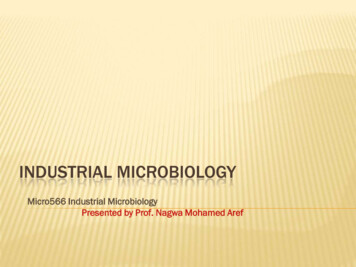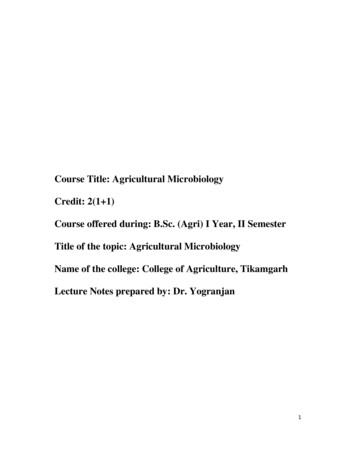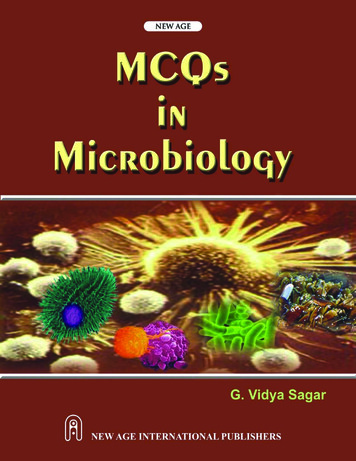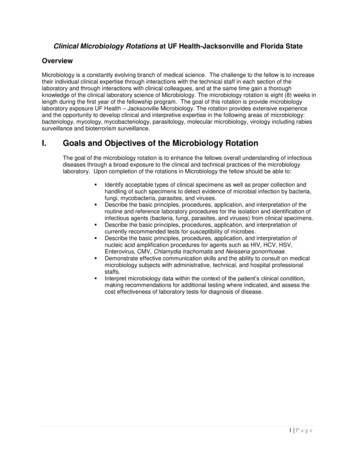
Transcription
INDUSTRIAL MICROBIOLOGYMicro566 Industrial MicrobiologyPresented by Prof. Nagwa Mohamed Aref
BrockBiology of Microorganisms11th editionISBN 0-13-196893-9Prentice Hall
FERMENTATION TECHNOLOGYFigure 28.10
INDUSTRIAL MICROBIOLOGYAmino acids Citric Acid Enzymes Vitamins Antibiotics Steroids
MICROBIAL METABOLISMSugarSaccharomyces cerevisiaeMalic acidEthyl alcoholLactic acid bacteriaEthyl alcohol CO2Lactic acidAcetobacter or GluconobacterAcetic acid
CHEESE Curd: solid casein fromlactic acid bacteria andrennin Whey: liquid separatedfrom curd Hard cheeses producedby lactic acid bacteria Semisoft cheesesripened by Penicilliumon surfaceFigure 28.8a
GROWTH IN BATCH CULTURE
Insert figure 26.35Origins of metabolites8
Insert Table 26.3Industrial products9
10
SECONDARY FERMENTATIONFigure28.11b
PRIMARY FERMENTATIONFigure 28.11a
PrimarymetaboliteSecondarymetabolite
1.Microbial cells or cell products2. Enzymatic biotransformation products3.Fermentation products (de novo synthesis)
CONCEPT OF INDUSTRIALFERMENTATION
WHAT IS FERMENTATION? Pasteur‟s definition: “life without air”, anaerobe redox reactions in organismsNew definition: a form of metabolism in which theend products could be further oxidizedAny Microbe requires Water, Oxygen, Energy source,Carbon source, Nitrogen source and Micronutrientsfor the growth.Carbon & Energy source Nitrogen source O2 other requirements Biomass Product byproducts CO2 H2O heat
DEFINITION OF FERMENTATION: Fermentation technology is the oldest ofall biotechnological processes.The term is derived from the Latin verbfevere, to boil--the appearance of fruitextracts or malted grain acted upon byyeast, during the production of alcohol.Fermentation is a process of chemicalchange caused by organisms or theirproducts, usually producing effervescenceand heat.Microbiologists consider fermentation as'any process for the production of aproduct by means of mass culture ofmicro-organisms'.Biochemists consider fermentation as 'anenergy-generating process in whichorganic compounds act both as electrondonors and acceptors';Hence fermentation is „an anaerobicprocess where energy is produced withoutthe participation of oxygen or otherinorganic electron acceptors‟.
INDUSTRIAL UNITPackingStoreEffluenttreatmentCulture roomPilot labPurificationQC & QARaw materialtesting labRecoveryProductionplant
OUTLINE OF A FERMENTATIONPROCESS
.
DOWNSTREAM PROCESS
STEPS IN FERMENTATION Fermentor selectionMicrobial Strain selectionFermentation Media SelectionFermentation processUpstream processingDownstream processingQuality Control & AssuranceProduct RecoveryPackaging
.FERMENTOR SELECTION
Earlier times .
FERMENTOR STAGESHAPEMATERIALSIZE
LABSCALE FERMENTOR
PILOT SCALE FERMENTOR
PRODUCTION TANKS
.Basic Design .
Cross section of a fermenter for Penicillin production
A BIOREACTORDIFFERS FROM AFERMENTER IN THATTHE FORMER IS USEDFOR THE MASSCULTURE OF PLANTOR ANIMAL CELLS,INSTEAD OF MICROORGANISMS
Parts of a fermentor Aeration & agitation system Impeller Sparger Baffles Load cells Inlet & exit gas analyser ph meter Flow cell Steam line
PARTS OF A FERMENTORIMPELLER Impeller blades
AGITATION Insteadof a traditional propeller agitator a newvibromixer is used. A strong motor moves one or morestirring discs up and down. The major advantage is anefficient mixing and aeration of the culture mediumtogether with very complete separation of the inside of thevessel from the outside by a low cost silicone membrane. No vortex is built up and baffles are eliminated.Thistype of agitation is also gentler on the cells and foamingis reduced with max mixing efficiency . The frequency of agitation is controlledby a microprocessor and can be variedthrough a broad range.
AIR INPUT/SPARGER The flow rate can be set from 0 to 5 l/min in 0.1l/min steps. A precise mass-flow meter is used.Commonly used floating ball capillaries(rotameters) give accurate readings in this case.A self-cleaning elastic air micro-sparger hasbeen developed. Its special construction allowsan automatic elimination of salt deposits, whichwould block the airflow in normal spargers. Thisis important particularly for micro-spargershaving very narrow channels.
LOAD CELL A load cell is a transducer that is used to convert aforce into electrical signal. The strain gauge convertsthe deformation (strain) to electrical signals.A load cell usually consists of four strain gauges in aWheatstone bridge configuration.The electrical signaloutput is in millivolts and requires amplification byan instrumentation amplifier.The output of the transducer is plugged into analgorithm to calculate the force applied to thetransducer.
BAFFLES
TEMPERATURE CONTROLA new infrared (IR) radiator with a gilded parabolicreflector is used to warm the culture broth. The heatradiation (150W) is concentrated on the bottom of thevessel where it is absorbed by the medium in a similarway to the sun heating water.There is no overheating at any volumeof the culture. overshooting of thetemperature is reduced & theTemperature can be controlledmore precisely.The temperature sensor is placeddirectly in the pH sensor and is usedat the same time for an automaticcorrection of pH and pO2 electrodes.
PH MEASUREMENT ANDCONTROLpH is measured by a combined,sterilizable pH electrode withincorporated temperature sensor. Due to multiple Variopin plug it canbe sterilized without any protection. The pH value has an automatictemperature correction. The addition of acid or base iscontrolled by a microprocessor.
PO2 MEASUREMENT ®ULATIONA sterilizable Clark-type electrode with large cathodemeasures the concentration of dissolved oxygen witha glass reinforced TEFLON membrane giving fastresponse times and short polarization. Themicroprocessor performs a semiautomatic two-pointcalibration with automatic temperaturecompensation. The regulation of dissolved oxygen isobtained by a variation of the flow rate of air.
CONTINUOUS FERMENTATION(CHEMOSTAT)A scale adaptor allows weighing of thefermentor. It is simply placed under the frontpart of the fermentor body and connected to theX-channel input of the fermentor. By means ofa pump connected to the fermentor, the weight(volume) of the culture can be kept constant.This allows therunningof continuous culturesat low cost.
GAS FLOW CONTROLLERFlow controller system specially designed for the usetogether with laboratory bioreactors and fermentors.It allows the control of pH of cell culture by controlledaddition of gaseous CO2, control of nitrogen or of anyother gas with suitable controller.A high quality laminar mass flow sensor measuresthe flow rate given by the digital display controlled bya microprocessor.The flow rate can be programmed& volume totalized.
HIGH-QUALITY PERISTALTICPUMPSThey are connected by a single cable to thesockets on the rear side of the fermentor.Since the pumps are not integrated into thefermentor they can be used for otherapplications elsewhere in the laboratory (e.g.for chromatography etc.). This representsconsiderable savings for the user.A new connection system provides doublesealing of the tubing and, therefore, reducesstrongly the contamination probability duringthe transfer of solutions into the vessel.
INOCULATION AND SAMPLINGPORTSInoculation, addition of acid or base andsample removal is made through fourstainless steel capillaries equipped withdouble sealfittings.
MEASUREMENT ANDREGULATIONThe control panel consists of an LCD display andcontrol buttons.All parameters (temperature, pH, pO2, air flow rate,agitation and one free selectable parameter, e.g.pCO2, optical density, antifoam etc.) are visible at aglance on a large LCD back light display .The limits of low or/and high alarm can be set.After alarm activation an acoustic signal is heard, theindication appears on the display and an electricsignal is generated on the rear side connector of thefermentor.Each fermentor can be coupled to a PC thusunlimited possibilities for control and dataprocessing.
STEAM LINE Sterilization by Steam
FOAM SENSORS This is the only instrument for foam analysisbased on the pressure drop technique . Theimportant feature is that due to the appliedpartial vacuum the foam in the measuring cellsis essentially homogeneous over the whole foamcolumn. measure the most important foamparameter in terms of foam stability and foamlifetime at constant capillary pressure in theliquid phase of the foam
SENSORSPressure sensing sensorAir Leak SensorThermal Sensor
Flow sheet of a multipurposefermenter and its auxiliaryequipment51
SELECTION OF MICROBIAL STRAINFOR THE FERMENTOR
Isolation and Screening ofMicroorganisms It should be pure, and free from phage. It should be genetically stable, but amenable to geneticmodification. It should produce both vegetative cells and spores; speciesproducing only mycelium are rarely used. It should grow vigorously after inoculation in seed stagevessels. Should produce a single valuable product, and no toxic byproducts. Product should be produced in a short time, e.g., 3 days.It should be amenable to long term conservation. The risk of contamination should be minimal under theoptimum performance conditions
Strain Improvement Product yields can be increased by(i) developing a suitable medium forfermentation,(ii) refining the fermentation process(iii) improving the productivity of thestrain. Strain improvement is based on thefollowing three approaches:(i) mutant selection,(ii) recombination, and(iii) recombinant DNA technology.
MICROBIAL STRAINSELECTIONScreening-Primary Primary screening is timeconsuming and labour intensivesince a large number of isolateshave to be screened to identify afew potential ones. However this ispossibly the most critical step sinceit eliminates the large bulk ofunwanted useless isolates, whichare either non producers orproducers of known compounds. Crowded plate Technique Auxanography Enrichment Culture technique Use of Indicator dye
MICROBIAL STRAIN SELECTIONSecondry Screening Gene Expression Metagenomics Random PCR
REQUIREMENTS FOR THEGROWTH & FERMENTATION OFTHE elatorsBuffers,MediaAntifoaming agentTrace elementsGrowthfactors
.Fermentation medium Define medium nutritional, hormonal, and substratumrequirement of cells In most cases, the medium is independent of the bioreactordesign and process parameters Even small modifications in the medium could change cell linestability, product quality, yield, operational parameters, anddownstream processingFermentation medium consists of: Macronutrients (C, H, N, S, P, Mg sources water, sugars,lipid, amino acids, salt minerals) Micronutrients (trace elements/ metals, vitamins) Additional factors: growth factors, attachment proteins,transport proteins, etc)For aerobic culture, oxygen is sparged52
FERMENTATION MEDIA
CarbonsourceNitrogensource Glucose Corn sugar, Starch, Cellulose Sucrose Sugarcane, Sugar beet molasses Lactose Milk whey Fats Vegetable oils Hydrocarbons Petroleum fractions Protein Soybean meal, Cornsteep liquor,Distillers' solubles Ammonia Pure ammonia or ammonium salts Nitrate Nitrate salts Nitrogen Air
FERMENTATION MEDIAFermentationMedia HC & Veg oils
TYPES OF ewaste liquorCorn steepliquorFruit juicesWoodmolasesSoya beanmealRice StrawDistillersSolublesCheeseWheyHydrocarbons& Veg oilsVeg Oils
ETHANOL PRODUCTION FROMSEVERAL SUBSTRATES
InoculumsIncoculum is the substance/ cell culture that isintroduced to the medium. The cell then growin the medium, conducting metabolisms.Inoculum is prepared for the inoculationbefore the fermentation starts.It needs to be optimized for betterperformance: Adaptation in the medium Mutation (DNA recombinant, radiation,chemical addition)54
INOCULUM DEVELOPEMENT
Fermentation techniquesSubmerged FermentationSurface FermentationThe microorganisms are cultivated on theSurface of a liquid or solid substrate.11
BATCH FERMENTATION
Continuous Fermentation
TYPES OF FERMENTORSTOWER FERMENTOR
TRICKLING FILTER
BIOREACTOR
FRINGS GENERATOR
ROTATING DRUM BIOREACTOR
CAVITATOR
AIR LIFT FERMENTOR
BUBBLE CAP FERMENTOR
HORTON SPHERES
ACTIVATED SLUDGE FERMENTOR
Primary vs. Secondary metabolismPrimary metabolites: produced during active growth generally a consequence of energy metabolism andnecessary for the continuedgrowth of the microorganismSubstrate A ProductSubstrate A B C Product ethanol, lactic acid,
Secondary metabolites: synthesized after the growth phase nears completion a result of complex reactions that occur during thelatter stages of primary growthSubstrate A B C Primary metabolism (no product) D E Product of secondary metabolismSubstrate A B C Primary metabolism (no product)afterwards, the product is formed by metabolism of anintermediateC D Product growth phase trophophase idiophase phase involved in production of metabolites citric acid, antibiotics,
Fermentation products from pyruvate
Insert figure 26.36biotransformation81
GENERAL CONCEPTS IN INDUSTRIALMICROBIOLOGYBulk production of organic compoundssuch as antibiotics, hormones, vitamins,acids, solvents, and enzymes Any processes involving fermentation 86
Mutant strains of bacteria and fungi thatsynthesize large amounts of metabolites Primary metabolites - produced during majormetabolic pathways and are essential tomicrobe’s function – amino acids, organicacids synthesized during logarithmic growth Secondary metabolites – by-products ofmetabolism that may not be critical tomicrobe’s function – vitamins, antibiotics, andsteroids synthesized during stationary phase 87
Many syntheses occur in sequentialfashion involving more than oneorganism. Biotransformation – waste product of oneorganism becomes the building block ofthe next 88
FROM MICROBIAL FACTORIES TOINDUSTRIAL FACTORIESProduce appropriate levels of growth andfermentation in a carefully controlledenvironment Commercial fermentation carried out infermentors – large culture devices withmechanisms for controlling environment 89
Insert figure 26.38Industrial fermentor90
SUBSTANCE PRODUCTION Steps in mass production:Introduction of microbes and sterile mediainto reaction chamberFermentationDownstream processing (recovery,purification, packaging)Removal of wasteCarried out aseptically and monitored forrate of flow and quality of product91
92
Batch fermentations – substrate added tosystem all at once and taken through alimited run until product is harvested Continuous feed systems – nutrients arecontinuously fed into the reactor andproduct is siphoned off throughout run 93
Pharmaceutical products antibioticsvitaminsvaccinesMiscellaneous products biopesticidesenzymesamino acidsorganic acidssolventsnatural flavor compounds94
THANKSFor the Patient hearing
INDUSTRIAL MICROBIOLOGY Micro566 Industrial Microbiology Presented by Prof. Nagwa Mohamed Aref . Brock Biology of Microorganisms 11th edition ISBN -13-196893-9 Prentice Hall . FERMENTATION TECHNOLOGY Figure 28.10










